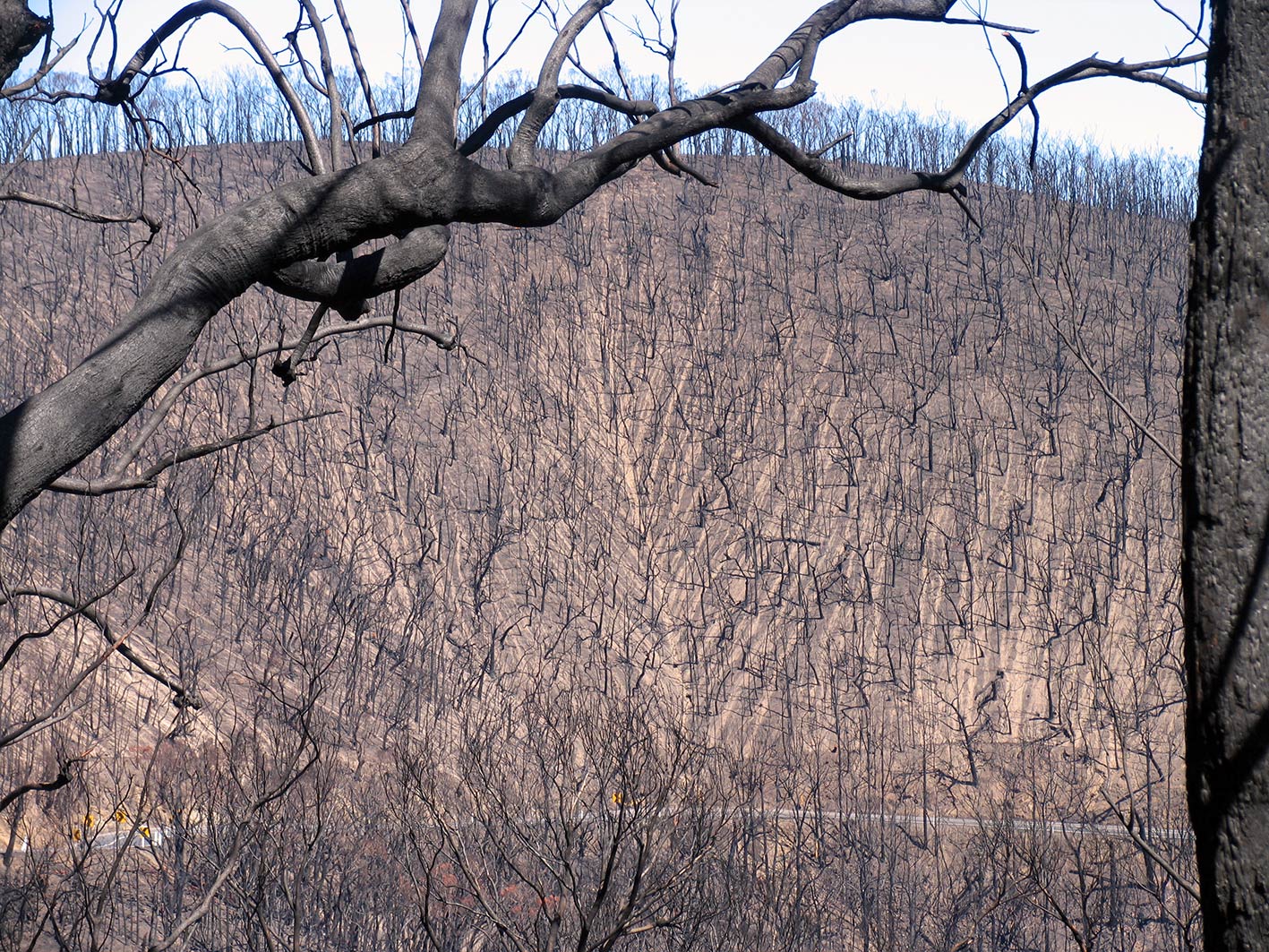The worldwide 'wildfire' problem

By Gill, A. M., Stephens, S.L. and Cary, G.J. (2013)
Fires raging across the countryside through forests and farms create headlines around the world when they invade cities and towns and create mayhem.
Valparaiso in South America experienced this in April 2014, but most Australians would remember the loss of 173 lives and around 2000 houses in Victoria in 2009. Other serious events since then have occurred near Hobart, Tasmania, and Sydney, New South Wales. Such headline events are the epitome of the “wildfire problem” where not only are social assets affected; but economic and environmental assets are also deeply involved.
The photos show an erosion pattern on the hillsides near Melbourne after the forest was completely laid bare; however, perhaps to the surprise of many, the trees then leafed out and gave an encouraging lift to affected residents living in the same region. Many people incorrectly believe that the forest is destroyed when it looks like the upper picture shown here.
Dr Malcolm Gill and Associate Professor Geoff Cary of the Fenner School together with Professor Scott Stephens from University of California, Berkeley, investigated the world-wide wildfire problem. They defined four main ways of dealing with the issues:
- Control fire regimes
- Make the assets (houses, people) more resistant
- Relocate the assets (leave the area permanently or at the time of threatening fire weather)
- Put measures in place to allow more rapid recovery and adjustment to the new circumstances created by the fire.
“There are long-term and short-term aspects to each of these” says Associate Professor Cary
Many people believe authorities let them down during and after fires, and should have tried harder, but they are thrust into extreme circumstances with no practice and limited resources. If they in fact had sufficient resources to deal with extreme circumstances, the cost to taxpayers would be enormous, unpopular and rarely used. Many people are unprepared even to the extent of having insufficient insurance or none at all.
There are no easy solutions to the “worldwide wildfire problem” but there are many partial “solutions”. Some farmers choose to concentrate grazing in paddocks near the homestead over summer so that grass fuels is low; foresters and conservation managers may choose to implement programs of prescribed burning, which also have effects on the resources being managed.
Householders may choose to keep gardens as green as possible and have water supplies and hoses that can be used when a fire occurs. Authorities may act in many ways from weather forecasting to treating road verges to advising citizens what to do in case of fire. Dr Gill warns however, “Risk might be reduced by preparedness but, unfortunately, the risk is never eliminated.”
The worldwide wildfire problem is not going away any time soon. It is likely to be made worse in areas where people are encroaching more onto fire-prone land and where climate change is drying areas that are normally wetter. Thus, there is the unpleasant potential for the worldwide wildfire problem to be manifest in new areas where people are likely to be unaware and unprepared. It is a challenge to define where these areas are.
Clarifications
“Control fire regimes” means reducing the number of people-caused ignitions, controlling spread (through fuel treatments, suppression), controlling fire intensity (flame height, fire-heat, fire speed) and frequency of fire. The idea is to “control” fires to achieve desirable or neutral outcomes or minimise damage. “Control” in this context could, paradoxically, mean “decide to leave it alone” or prescribe fire for management of assets; it could mean slash the grass.
“Authorities let them down” usually means that “nobody turned up to help when my house was threatened by fire”. So, yes, “emergency services” is appropriate. The point is that authorities are overwhelmed in a big event and never have the resources to deal with its magnitude.
“.. programs which also ..”. For example, cutting farm fences, draining dams, bulldozing tracks in areas sensitive for biodiversity conservation or water conservation.
“treating road verges”: Yes, to reduce chances of inappropriate ignition and fire spread.
“All the authors engage with local, regional and national authorities to various extents in order to help attain better outcomes for fire-prone social, environmental and economic assets - like people, biodiversity and houses.”
Figure Caption: Kilmore East Black Saturday fire effects near Kinglake, Victoria. a) March 2009, approximately one month after the fire; b) March 2010 (Photos: Geoff Cary (copyright)).
The worldwide ‘‘wildfire’’ problem. Ecological Applications, 23(2), 438–454
